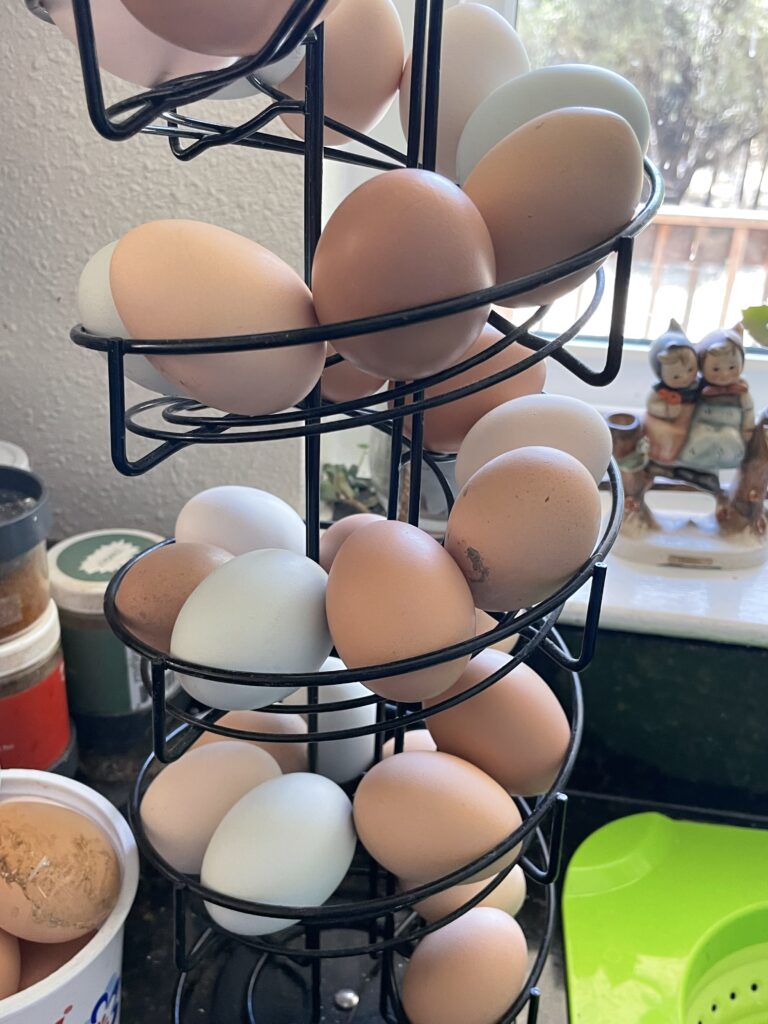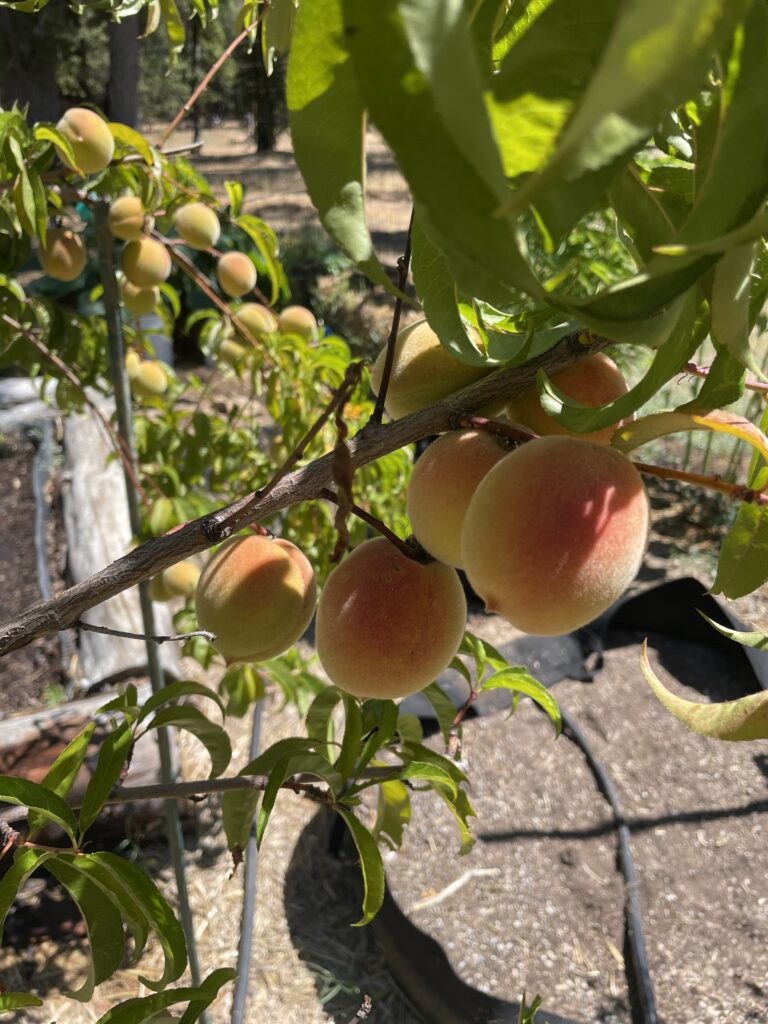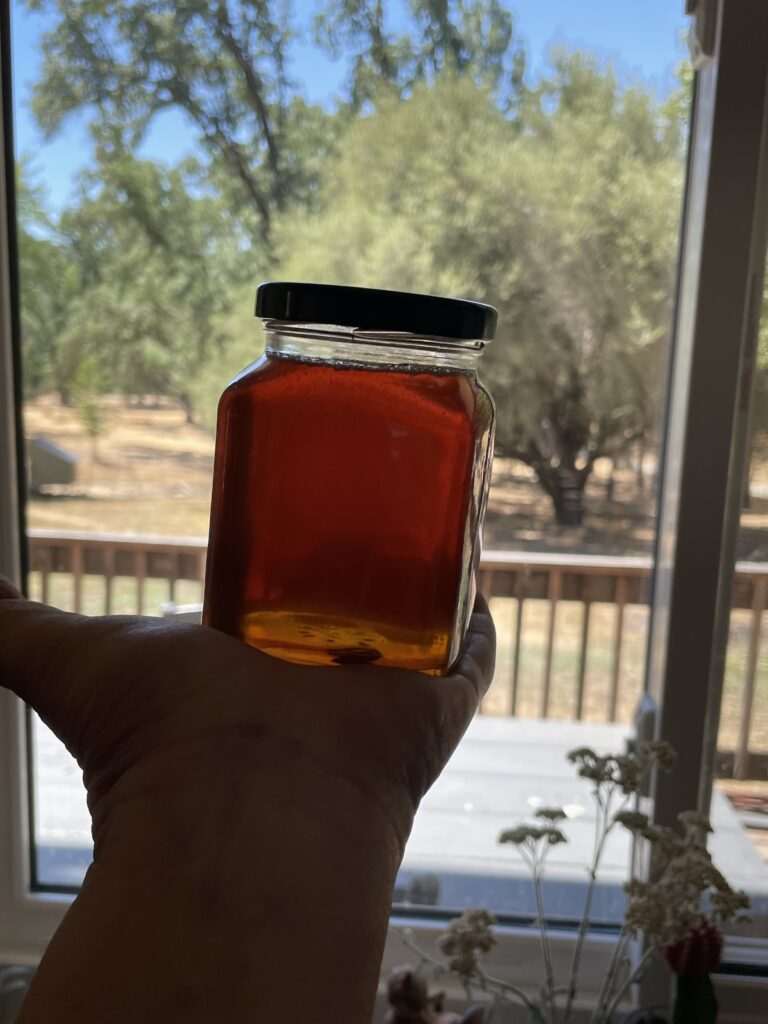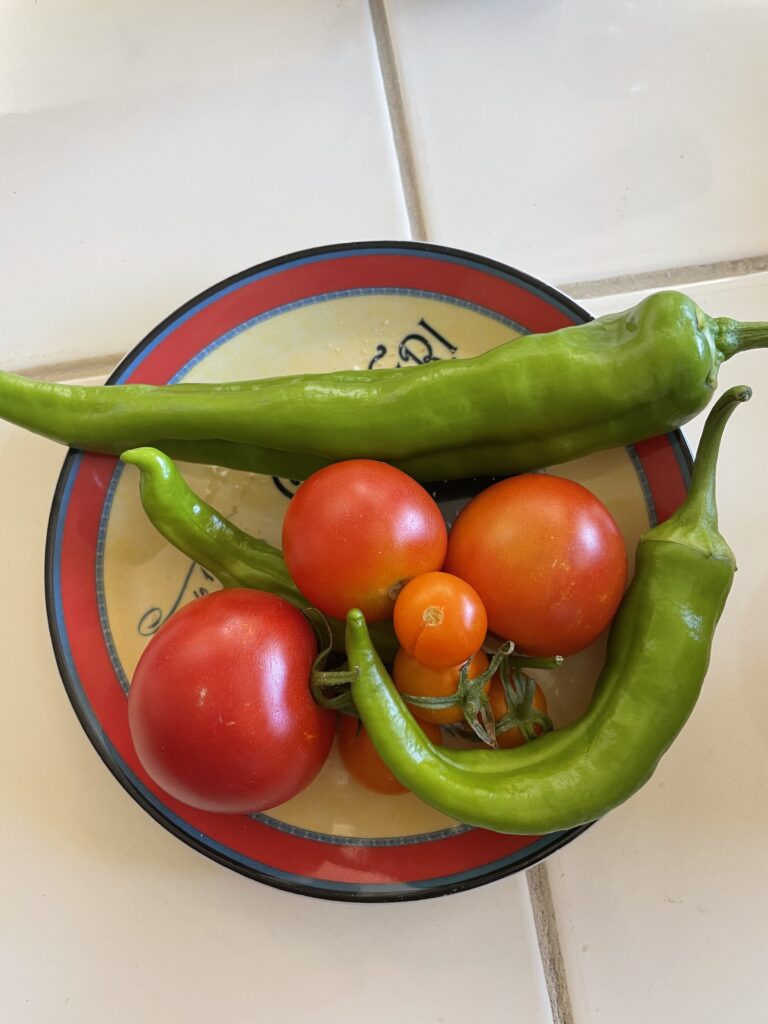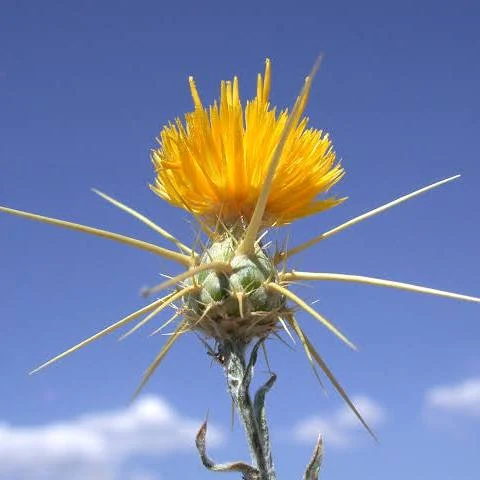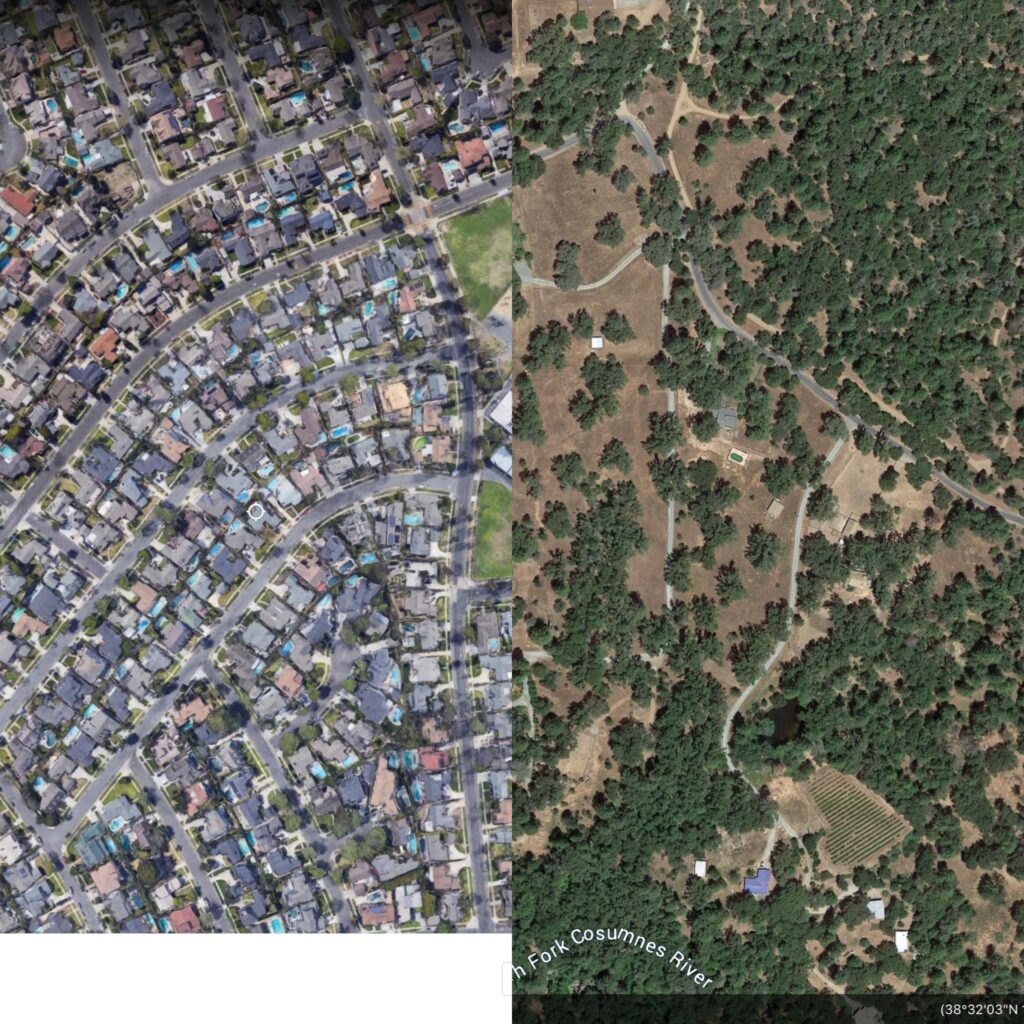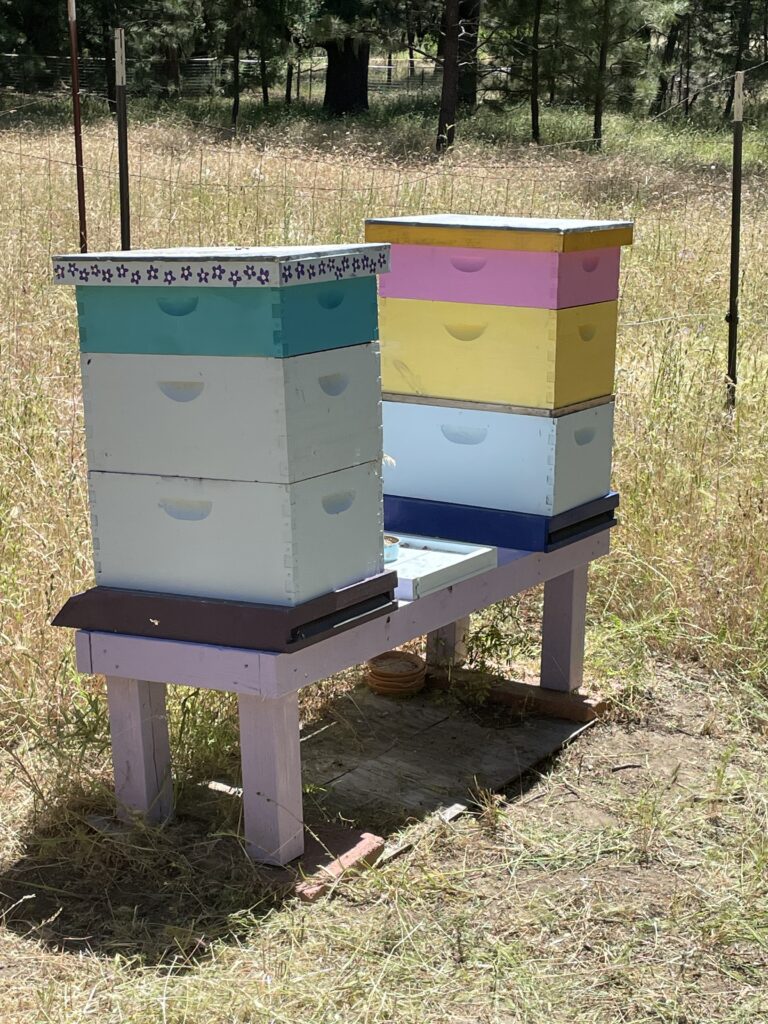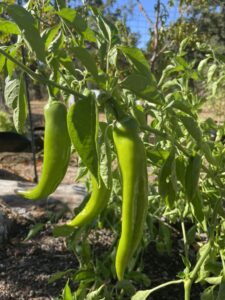

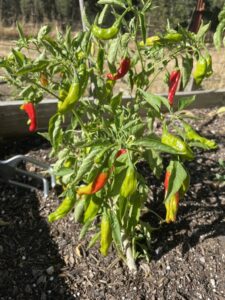
Four varieties of peppers — Shishito, Anaheim College, Bridge to Paris, and Alma Paprika, all from Territorial Seed — were planted February 19-21 in the green starting trays — I soaked them in black tea for a day (don’t remember where I heard this), and scuffed seed coats as best I could — they’re small, after all, so I spread the damp seeds on a little piece of sandpaper and kind of rolled them around with my fingers. Karen’s peppers had been in their trays for some weeks by the time I started. Karen seems to be my catalyst, which is good, because I do delay, especially since when it’s time to start a new project like planting peppers. Days are short, dark, and cold, and it doesn’t FEEL like gardening time. I’m likely immersed in another something-or-other that wants my time and attention, so I’m quite willing to kick a new project start date down the road. Last night, when I was reviewing pepper growing lore, a gardening guru I follow “Joe Gardener,” declared that he starts his peppers on January 1st or 2nd. Well, la-de-dah.
On March 9th, I noted that maybe I had killed my pepper starts by neglecting to water them. I saw sprouts in just four out of twelve rows of the starting trays. So I soaked the seeds I had left, again in black tea, and started more seeds, 2-3 seeds per cell, planning to thin out the smaller ones as the tray sprouted.
Plants went into the ground just after Mother’s Day, when frost danger is likely past, although I do remember a recent year where there was a late frost –maybe 2022? — and many growers, including local vineyards, lost plants to the cold. So plants go in with an optimistic heart, knowing the heart could be broken in one frigid night.
The pepper bed was planted in mid-May. Out of all the seeds started, twenty five plants made it into the garden.
Nine of these: Bridge to Paris peppers, description by Territorial Seed: 83 days. We consider Bridge to Paris among the best all-around pepper we’ve grown. A sweet Italian type, this marvel offers staggeringly huge yields of big, elongated fruit with very few seeds and excellent flavor. Emerging green and ripening to red, the peppers can reach 7–9 inches long with a fruity taste. Enjoy the harvests fresh, fried, dried or smoked. The plants get tall, up to 30 inches in our trials, and load up with over two dozen fruit per plant. Thanks to Hudson Valley Seed for offering this exceptional de-hybridized pepper.
We have not experienced “staggering huge yields,” and plants are nowhere near 30″ tall. Because I started with 9 of these plants, I was able to observe and learn more than I have in previous years. I lost 2-3 plants right out of the gate — they were dead by June. The remaining 6 are still producing, but not blowing my mind. I’ve learned this year that peppers really must be staked as they get established, and then they need a cage. When the plant doesn’t have adequate support, the heavy fruit can damage or break limbs, and that open wound invites disease — and this did happen with both the peppers and tomatoes this year. So note for 2026: support the growing plants with good cages. The remaining plants have been productive, but I see this variety has more potential. These peppers when harvested will end up in the Pickled Roasted Peppers recipe on the Ball Glass canning website.
Eight Alma Paprika peppers, description by Territorial Seed: 80 days. A sweet, prolific, multi-use pepper that can be eaten fresh, pickled or dried. Plants are loaded with thick-walled peppers that develop just a hint of warmth. The 1–2 inch fruit start out creamy white and then turn to orange before finally turning shiny red. Harvest red for most uses.
The seed company did not say how tall these get, but mine are shorties, foliage and fruit happening very close to the ground, which is worrisome. In fact, I am wondering whether I should have pruned away foliage that is growing low on the main stem. But I am enjoying these peppers — great for snacking.
Three Shishito peppers (“Takara”), description by Territorial Seed: 60 days. Shishitos are quickly rising to the top ranks in popularity for their tasty, mild spice and snackability. Takara produces richly flavored, 3 inch long, light green peppers that ripen to red. Early and productive, the compact, well-branched, spreading plants provide heavy harvests of uniform, slender, bite-sized peppers with sturdy stems. We love Takara lightly tossed in oil, blackened on the grill, and tossed with a bit of coarse sea salt.
One of these plants died pretty early in the season, due to careless hose dragging: I ripped that baby right out of the earth without even realizing it. I continue to harvest peppers from the other two — both of the remaining plants are productive, with lots of tiny peppers — but they remain on the vine and on the counter, waiting to be chopped up and tossed into something. They are a bit spicy, which I like but Vicki doesn’t. I roasted some in the oven with olive oil, and to my shame, have not yet eaten them. I think this might be one of those vegetables where I like the idea better than the actual fruit, but I am still hoping that I will hit on the right recipe or the right combination of elements to find how these peppers fit into my diet.
Five Anaheim College 64, description by Territorial Seed: 74 days. If you like a medium sizzle for your palate, try these peppers. Same as the green Anaheim chilis you find in the grocery store, but better because you’ll get to eat them fresh and full of flavor! Anaheim College 64 yields 6–10 tasty fruit per plant, each 6–8 inches long. The thick-walled conical fruit turn from green to red. Excellent roasted and stuffed or minced into salsa and guacamole.
Lots of green fruit on the plants so I’m waiting for them to blush red. Of the five plants I put into the ground, all five are still standing, but again, they needed support to reach their full potential. They flopped over and I had to tie them up on bamboo stakes.
Most of these peppers will find their way into the aforementioned Pickled Roasted Pepper jars later on this month.
I guess my pepper growing season was better than adequate, but not great yet. Maybe we could say “good,” or “B-” because I am harvesting lots of fruit.
Notes for 2026: Even though they say that crop rotation is not important for home gardeners, I am going to go ahead and use a different bed for the peppers next year. I’ll continue to amend and build the soil with composted pony poop (thank you, Lima Girls!) and kitchen compost. Cover it all for winter with a thick layer of oak leaf mulch. Remember peppers like phosphorus (flower, fruit) so offer bonemeal on the day of planting; any feeding that’s done over the growing season should be phosphorus dominant (higher second number). High nitrogen will produce lots of foliage and not much fruit. Get (make) cages for the peppers as they get established — make the cages out of those wire cattle panels — I’m going to need help with this.

